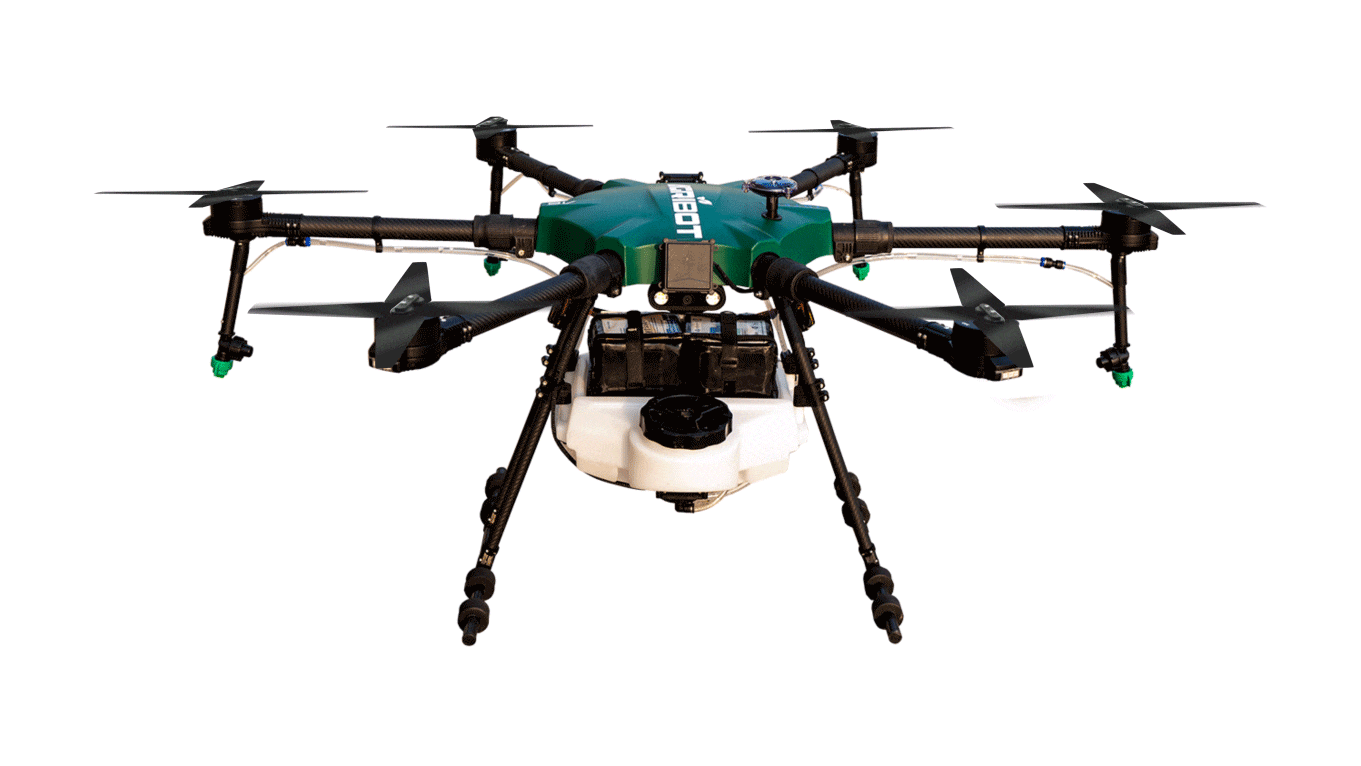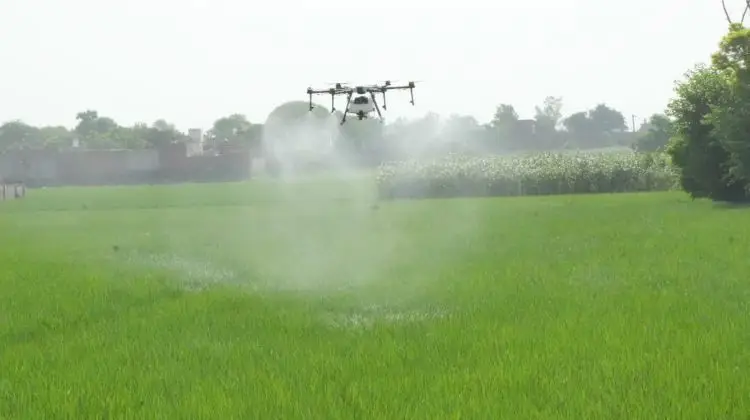
Best Agriculture Drone for Spraying Fertilizer and Pesticides in India
Advancements in drone technology have opened up new opportunities for increasing agricultural productivity and efficiency. For farmers in India, drones can provide an affordable and effective means of pesticide drone spraying over large crop areas. However, with many drone models now available, determining the best option for a farming operation’s specific needs can be challenging. An ideal agriculture drone for spraying in India would need to be relatively inexpensive, able to carry a useful payload, provide stable and consistent flight, and be suitable for the climate conditions found in many of India’s agricultural regions. This article aims to highlight the best agriculture drone for spraying fertiliser and pesticides. Its purpose is to assist farmers in selecting a model that aligns with their specific requirements and budget.
What do we mean by agricultural drones?
Agricultural drones, also known as unmanned aerial vehicles, play a crucial role in agricultural operations by overseeing crop growth and enhancing overall crop yield. Essentially, these drones share similarities with those employed in photography or construction, with the key distinction lying in their adaptation to meet the specific requirements of farming.
Types of Drones in Agriculture
Various types of drones in agriculture serve specific roles, each tailored for distinct tasks. The primary drone types include:

Fixed-Wing Drones
- Resemble miniature aeroplanes.
- Extended flight time for field mapping, crop monitoring, and issue identification.
- Launched by hand, flown via remote control or pre-programmed plans.
- Ideal for precision agriculture but requires more open space.
Single-Rotor Drones
- Helicopter-like with a single rotor blade.
- Vertical take-off and landing for precise tasks.
- Larger, costlier, and suitable for advanced applications.
- Equipped with advanced sensors for crop mapping and analysis.
Multi-Rotor Drones
- Comprise multiple rotors for versatility.
- Maneuverable, suitable for close-range operations.
- Effective for mapping, surveying, and monitoring crops.
- Shorter flight times compared to fixed-wing drones.
Hybrid Drones
- Combine fixed-wing and multi-rotor features.
- Vertical take-off with extended range and endurance.
- Ideal for large-scale operations and adverse weather.
- Suited for mapping, crop scouting, and pesticide drone spraying.
Sensor Technologies in Agricultural Drones
- RGB Cameras: Capture high-res images for detailed crop analysis.
- Multispectral Cameras: Detect nutrient deficiencies and early signs of disease.
- Thermal Cameras: Measure heat signatures for stress and pest detection.
- LiDAR: Create 3D terrain maps for topographical analysis.
- GPS: Enables autonomous flight, accurate mapping, and issue identification.
How To Choose The Right Agricultural Drone?
While you are intending to choose the right agricultural drone, make sure you keep a handful of factors in view. They are mentioned below:
- Budget: Determine a suitable investment.
- Payload Capacity: Ensure the drone can carry the required sensors.
- Flight Time: Opt for extended flight time.
- Range: Consider the needed flying distance.
- GPS and Features: Look for GPS and obstacle avoidance features.
- Maintenance and Support: Check spare part availability and support services.
- Specific Needs: Choose a drone with sensors and capabilities aligning with farm requirements.
Best Agriculture Drone For Spraying Fertiliser And Pesticides
Farmers need reliable tools that can aid them in monitoring crops, managing plant health, and even handling tasks like spraying fertilisers and pesticides. Here are the best agriculture drone for spraying fertiliser and pesticides recommended for farmers:
1. Iotechworld AGRIBOT Drone:
AGRIBOT Drone emerges as a pioneering hexacopter drone designed to redefine the efficiency of pesticide spraying. With a robust structure and intelligent flight modes, it stands out as a reliable solution for farmers in India. AGRIBOT’s cutting-edge features, including autonomous capabilities and advanced safety measures, make it a standout choice in the realm of agricultural drones.
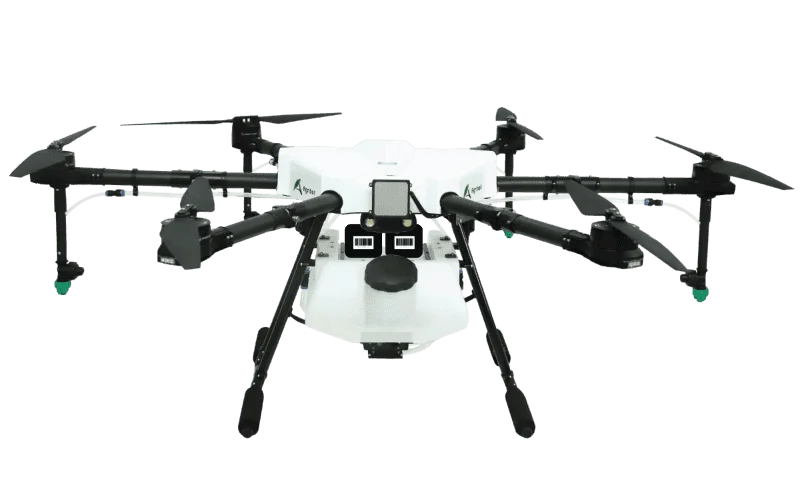
AGRIBOT Drone Key Features:
- Structure: Hexacopter design ensures unparalleled stability and reliability.
- Flight Modes: Autonomous and Loiter Mode for flexible and efficient operations.
- Spraying Capacity: Covers up to 6 acres/hour or 25 acres/day with multiple battery sets.
- Battery Flight Time: Up to 20 minutes per battery set, including payload dispersion.
- Safety Modes: Brake and RTL features to ensure secure and controlled operations.
- Smart Battery Fail Safe: Constant voltage monitoring guarantees a safe return to home.
- Resume Mission: Autonomous resumption of missions with impressive 50cm accuracy.
- Live Video Streaming: Equipped with a 2MP FPV Camera for real-time monitoring.
- Quick Spray: Completes spraying on a one-acre farm in just 7 minutes, averaging 25 acres daily.
- Water Saving: Requires only 10 litres for 1 acre, promoting efficient water usage.
- Safety: AGRIBOT ensures the safety of operators, crops, and soil, minimising residue for consumer safety.
- Bio-Efficacy: Achieves superior bio-efficacy in insecticide spraying compared to conventional methods.
- Chemical Utilisation: Best utilisation of chemicals, minimising wastage in all spraying mechanisms.
- Ease of Use: AGRIBOT’s AI-based features facilitate easy and safe spraying on any crop, terrain, or growth stage.
- Quality of Spray: Provides precise and uniform spray, penetrating till roots without causing crop damage.
- Yield Increase: Boosts yield up to 20% compared to conventional spraying methods.
2. Iotechworld Agribot A6 Drone:
Agribot A6 drone, a compact marvel in the realm of agricultural drones, represents a breakthrough in efficient and safe farming practices. With a focus on quick spraying, reduced water usage, and innovative safety features, Agribot A6 is poised to elevate the agricultural landscape in India.

Key Features of Agribot A6 Drone:
- Quick Spray: Achieves a remarkable 1-acre spray in just 7 minutes, covering 25-30 acres in a day.
- Water Conservation: Requires only 8-10 litres of water for 1 acre, contributing to sustainable farming.
- Safety Features: Incorporates radar-based collision avoidance, terrain following, and smart battery failsafe.
- Fleet Management: Enables owners to monitor utilisation and output via a computer dashboard.
- DGCA Approved: Adheres to regulatory standards, ensuring safe and legal operations.
- Drone Category: Falls under the small drone category, optimising versatility and manoeuvrability.
- Hexacopter Structure: Compact design with a height of 30 metres, ensuring stability in varied conditions.
- Battery Capacity: Equipped with a robust 21000mAh lithium-ion battery, offering up to 500 cycles.
- Dashboard – ONLINE: Provides an online dashboard for convenient monitoring and control.
- Obstacle Detection: Features obstacle detection and collision avoidance for enhanced safety.
- Transportation: Conveniently transported on a bike or backpack, ensuring portability.
3. Iotechworld AGRIBOT MX Drone:
Agribot MX drone, another innovation in Krishi Drone, is a medium-sized hexacopter drone catering to diverse agricultural needs. Its dual functionality and safety features make it a valuable asset for farmers.
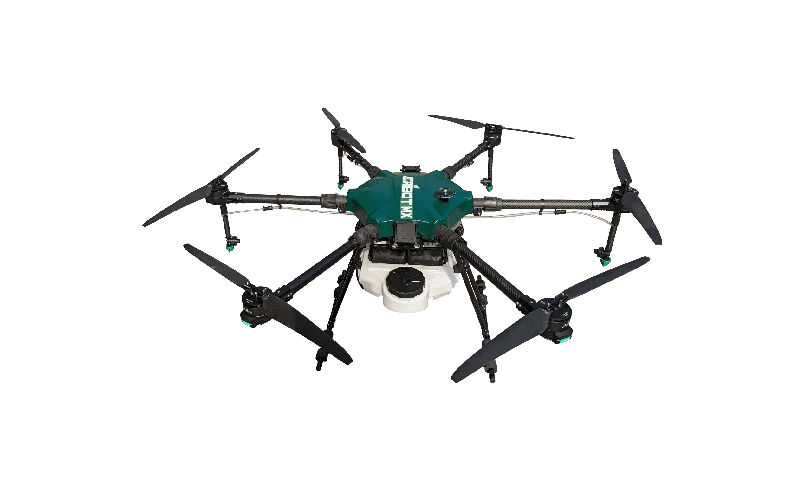
Key Features:
- Structure: Medium-sized hexacopter structure with advanced flight modes.
- Foldable Design: Facilitates portability for ease of transportation.
- Spraying & Broadcasting: Dual functionality for efficient agricultural operations.
- Safety Features: RADAR-based collision avoidance, terrain following, and smart battery fail-safe.
- Fleet Management: Owners can monitor drone utilisation and output through an online dashboard.
- Quick Spray: 1 acre in 7 minutes (25-30 acres daily).
- Limited Water Usage: Only 8-10 litres per acre.
- 2-in-1 Agri Drone: Capable of Spray and broadcast functions.
- Safety Features: RADAR-based collision avoidance and terrain following
4. Iotechworld Drishti Drone:
Drishti drone, a lightweight hexacopter aerial surveillance drone, is designed for reconnaissance and aerial surveys. With compatibility with various vision sensors and HD video transmission, Drishti proves to be a versatile asset.
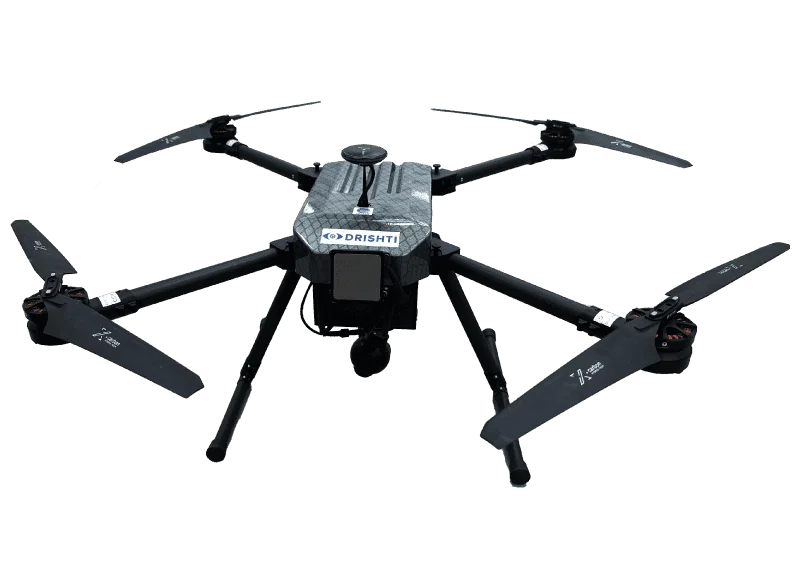
Key Features:
- Sensor: Multispectral for comprehensive data collection.
- Flight Time: Up to 45 minutes for prolonged surveillance operations.
- Power Source: Powered by battery or genset for flexibility.
- Functions: Specialised in aerial surveillance and reconnaissance.
- Payloads: Thermal Cameras, Multispectral Cameras, Speaker (with remote mic for mass control), Spot Light (High lumens LED light for search operations).
- Defence: Ideal for reconnaissance and surveys.
- Agriculture: Efficient farm surveys using multispectral sensors.
- Aerial Survey: Suitable for photogrammetry and videography.
5. Iotechworld Surveybot Drone:
Surveybot drone, a specialised drone for land surveying and mapping, is tailored for aerial surveys with advanced sensors and high accuracy. It serves as a valuable tool for data collection and processing over varied terrains.

Key Features:
- Sensor: 16 channel LiDAR for accurate data collection.
- Speed: 360° 3D high-speed scanning for efficient surveys.
- Flight Time: 25 to 180 mins for extended survey periods.
- Power Source: Battery and Engine for reliable performance.
- Functions: Specialised for data collection and processing during aerial surveys.
Also Read:
- Drones for Spraying Pesticides
- What is Kisan Drone?
- Farming Drones for Crop Monitoring
- Application of Drones in Agriculture
- Future and Challenges of Drones in Agriculture
Advantages of Agricultural Drones
Drones have become integral to modern agriculture, revolutionising traditional farming practices. With the global drone market in agriculture projected to grow at a compelling CAGR, reaching good numbers by 2025, their impact is undeniable.
- Optimised Operational Efficiency: Drones exhibit high efficiency, operating at double the speed of human labour without encountering the usual operational delays.
- Water Conservation through Technology: Utilising ultra-low volume spraying technology, agricultural drones contribute to water conservation when compared to traditional spraying methods.
- Cost-Effective and Low Maintenance: Characterised by sturdiness, affordability, and minimal maintenance requirements, agri drones present a cost-effective solution.
- Crop Monitoring: Drones supervise crop progress from seeding to harvest, enabling timely interventions.
- Plantation: Drones contribute to tree and crop planting, reducing labour and fuel consumption.
- Crop Spraying: Agri-drones equipped with reservoirs efficiently spray fertilisers and pesticides, reducing time compared to traditional methods.
- Check Crop Health: Drones provide rapid and accurate surveys of large farmlands, monitoring soil and crop health through infrared mapping.
- Avoid Overuse of Chemicals: Drones help prevent the overuse of chemicals by detecting signs of pest attacks.
- Prepare for Weather Glitches: Drones offer advanced weather predictions, helping farmers prepare for unexpected shifts.
- Monitor Growth: Throughout the crop lifecycle, drones monitor growth stages, providing accurate data for future planning.
Six Tips for Mastering Drone Technology in Precision Agriculture
Mastering drone use in precision agriculture requires careful consideration, adherence to regulations, and the right tools for capturing and processing valuable farm data.
- Assess the Need for a Drone: Before investing in a drone, carefully evaluate whether it’s a necessity for your farming tasks or if it’s a desire to join the trend.
- Choose the Right Drone: Determine the purpose of your drone use whether it’s for imaging, surveying, or monitoring plant health.
- Be Aware of Regulations: Check whether you need a licence to operate your drone.
- Check Flight Permissions: Use tools like the ‘Can I Fly There smartphone app from the Civil Aviation Safety Authority (CASA) to identify no-fly zones and ensure safe and legal drone operation in public areas.
- Fly in Ideal Conditions: Consider weather conditions for optimal drone performance.
- Have the Right Data Tools: After capturing drone data, ensure you have the necessary tools to process and analyse it. Invest in a laptop with a good graphics card for stitching images into usable maps.
Conclusion
In summary, drones have revolutionised agriculture and made the application of fertilisers and pesticides more efficient and cost-effective. The demand for effective pesticide spraying has led to the rise of advanced agricultural drones, providing Indian farmers with a transformative solution. Choosing the best agriculture drone involves considering various types, like fixed-wing and multi-rotor, tailored to specific field needs. These drones, armed with advanced sensors like RGB cameras and GPS, bring unparalleled precision to crop monitoring. This technology marks a significant shift in traditional farming practices, promising improved efficiency for farmers in India.
Frequently Asked Questions
Q.1 Do I need a certificate for agricultural drones?
Yes, acquiring a certificate is necessary for agricultural drones.
Q.2 Can Drones Operate in Hilly Areas for Agricultural Monitoring?
Yes, agricultural drones are capable of flying in hilly regions.
Q.3 How can drones contribute to time, cost, and resource savings in agriculture?
Drones, or unmanned aerial vehicles, play a crucial role in enhancing efficiency in agriculture. They excel in tasks such as surveying, mapping, crop spraying, livestock management, and monitoring, as well as irrigation.

